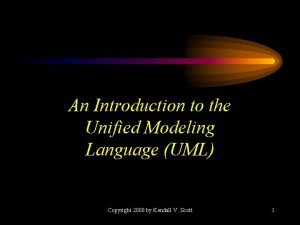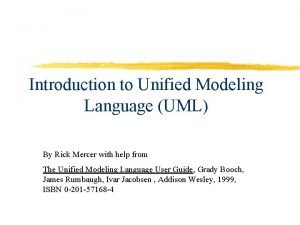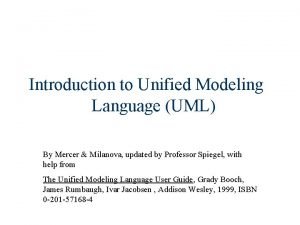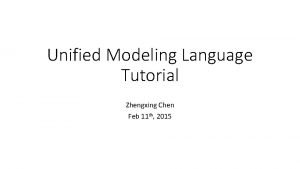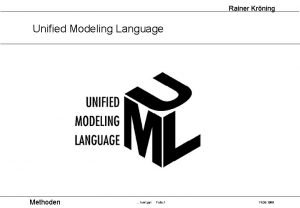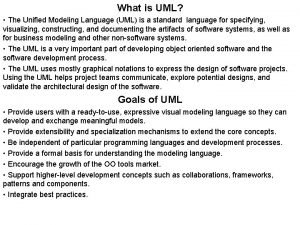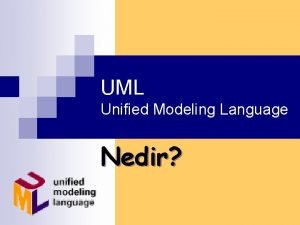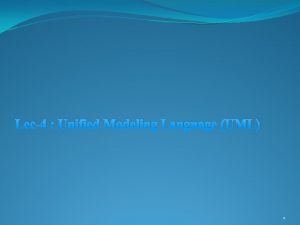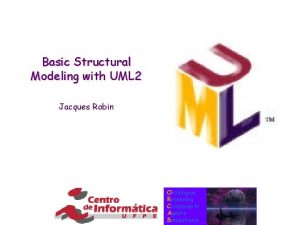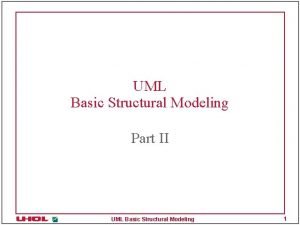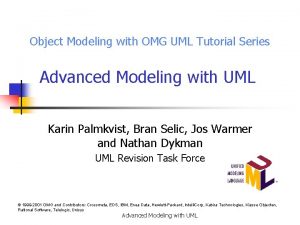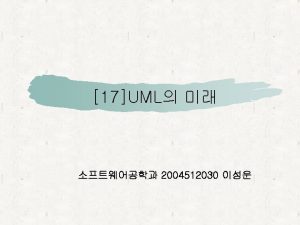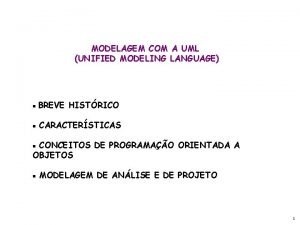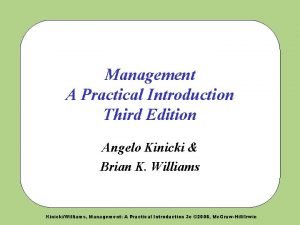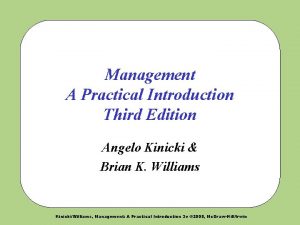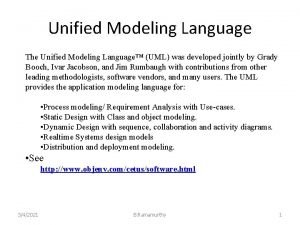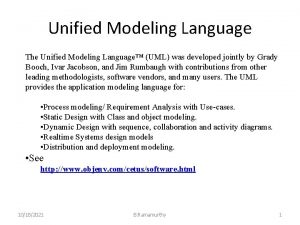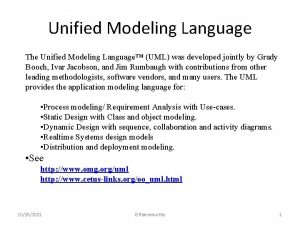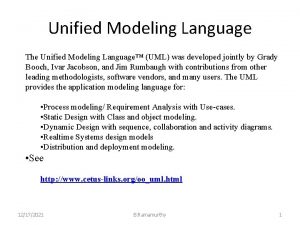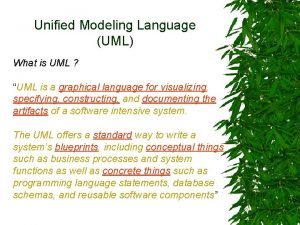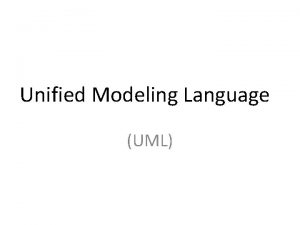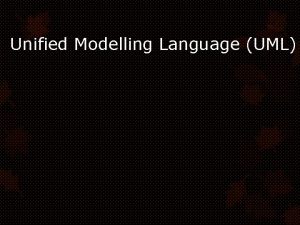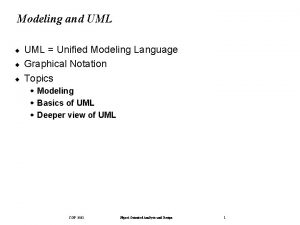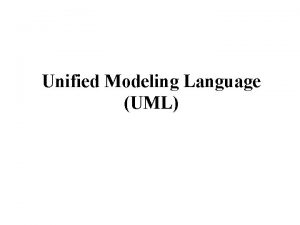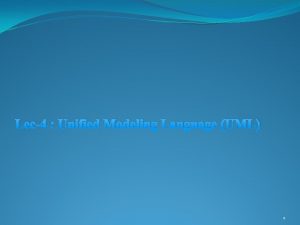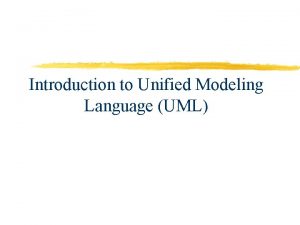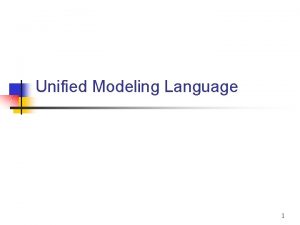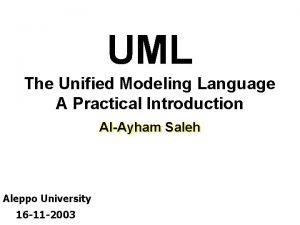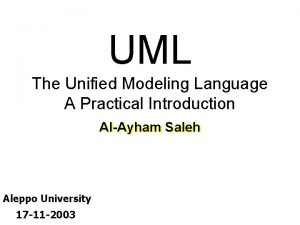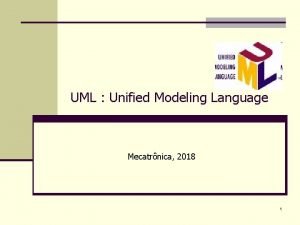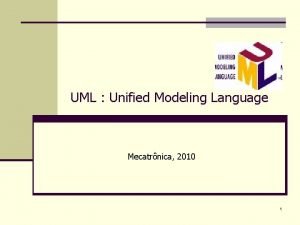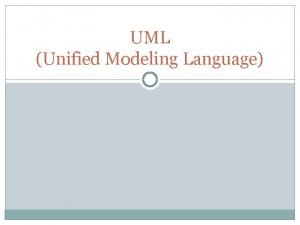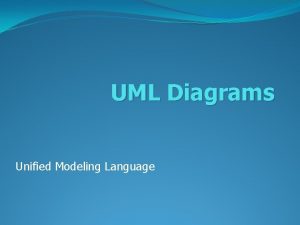UML The Unified Modeling Language A Practical Introduction















![Sequence Diagrams • Messages have a specific format [Condition] Sequence Number. Return value : Sequence Diagrams • Messages have a specific format [Condition] Sequence Number. Return value :](https://slidetodoc.com/presentation_image_h2/912360939a89fa8051e188a3a72e9813/image-16.jpg)








- Slides: 24

UML The Unified Modeling Language A Practical Introduction Al-Ayham Saleh Aleppo University 22 -11 -2003

UML Diagrams • • • Use Case diagrams Class diagrams Object diagrams Sequence diagrams Collaboration diagrams State chart diagrams Activity diagrams Component diagrams Deployment diagrams

Object Diagrams • Useful when you model reflexive associations • Represent Data, or samples of data • Object Diagrams are static Underline means an object

Sequence Diagrams • Detail how operations are carried out • Dynamic Diagrams • Organized according to time – The time progresses as you go down the page – The objects involved in the operation are listed from left to right according to when they take part in the message sequence. • Create a sequence diagram for each scenario

Sequence Diagrams

Sequence Diagrams • Sequence diagrams show instance exchange messages. • An instance can be: – An object, not a class – An actor

Sequence Diagrams • Messages can be Simple – One object sends a message to a passive object – The sender does not care what happens to the message – Useful when the recipient can not be controlled

Sequence Diagrams • Messages can be Synchronous – The sender sends the message – The recipient accepts the message, and notifies the sender with a message result. – The sender accepts the message result. • If the sender does not accept the message result, then the whole operation will not continue. • Synchronous messages are useful to represent procedure calls or modal dialogs.

Sequence Diagrams • Messages can be Asynchronous – The sender sends the message – The sender does not wait for the return of the message, it immediately continues execution. – The recipient may or may not send a reply. • Asynchronous messages are useful to model – Multithreading – Windows hooks – Windows sub-classing – Exception Handling – Modeless dialogs

Sequence Diagrams • Messages can be Timeouts – The sender sends the message – The sender awaits for the return of the message for some time. – Execution continues when the recipient replies, or after the timeout period if the recipient does not reply – The recipient may or may not send a reply. • Timeout messages are useful to model – System Calls – Cross-component calls

Sequence Diagrams • Messages can be Return messages – Results of procedure calls

Sequence Diagrams • Messages can be Constructors – The message creates the recipient

Sequence Diagrams • Messages can be Destructors – The message destroys the recipient

Sequence Diagrams • Messages have sequence numbers – The numbers represent the order of interaction

Sequence Diagrams • Messages have sequence numbers – Sequence number can be hierarchical
![Sequence Diagrams Messages have a specific format Condition Sequence Number Return value Sequence Diagrams • Messages have a specific format [Condition] Sequence Number. Return value :](https://slidetodoc.com/presentation_image_h2/912360939a89fa8051e188a3a72e9813/image-16.jpg)
Sequence Diagrams • Messages have a specific format [Condition] Sequence Number. Return value : = Message. Name(Arguments) [Condition] Sequence Number. *[iteration] Return value : = Message. Name(Arguments)

When to use Sequence Diagrams • To specify how instances interact • To show what happens before the other • To show the relationships/dependencies between interactions • To clarify each object requirements for all the possible scenarios of the system

Effective Sequence Diagrams • Use only instances and actors • Concentrate on actions, not on instance static details • Imaging as much real time scenarios as you can, and model them • Keep in mind that a programmer will read your design, so make it as clear as possible.

Collaboration Diagrams • Represent Object roles in a scenario of interactions • Are synonymous to sequence diagrams • Use the same message formats

Collaboration Diagrams

Collaboration Diagrams • Used to understand the structure of a scenario • Used to concentrate on what happens to each instance as a whole. • Can be converted to sequence scenarios

Static Modeling • Diagrams – Use Case Diagrams – Class Diagrams – Object Diagrams • Represent a static view of the system • Represent what happens, and who participates

Interaction Modeling • Diagrams – Sequence Diagrams – Collaboration Diagrams • Represent how things happen – Conditions – Flow of interactions – Flow of events – Flow of information

Workshop • Expand the previous workshop with the necessary interaction models – Collaboration diagrams for each scenario – Sequence diagram for each scenario
 Uml structure diagram example
Uml structure diagram example Introduction to the unified modeling language
Introduction to the unified modeling language Introduction to unified modeling language
Introduction to unified modeling language Introduction to unified modeling language
Introduction to unified modeling language Unified modeling language tutorial
Unified modeling language tutorial Introduction to uml ppt
Introduction to uml ppt Pengertian unified modeling language
Pengertian unified modeling language What-is-uml
What-is-uml Use case örnekleri
Use case örnekleri Unified modeling language adalah
Unified modeling language adalah Difference between static and dynamic diagrams in uml
Difference between static and dynamic diagrams in uml Omg unified modeling language
Omg unified modeling language Uml cardinality
Uml cardinality Helen c erickson
Helen c erickson Relational vs dimensional data modeling
Relational vs dimensional data modeling Superstruture
Superstruture Structural modeling in uml
Structural modeling in uml Uml modeling tutorial
Uml modeling tutorial Uml 2
Uml 2 Language
Language Introduction to modeling and simulation
Introduction to modeling and simulation Contoh proses stokastik dalam kehidupan sehari-hari
Contoh proses stokastik dalam kehidupan sehari-hari Angelo kinicki management: a practical introduction
Angelo kinicki management: a practical introduction Read management: a practical introduction
Read management: a practical introduction Baraceros 2016
Baraceros 2016

